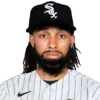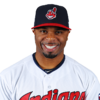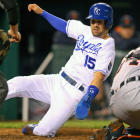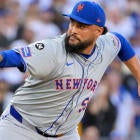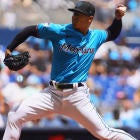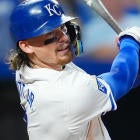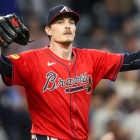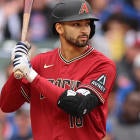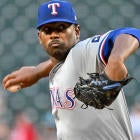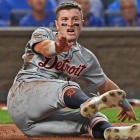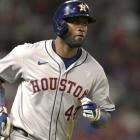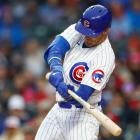I understand why you wouldn't want to draft Whit Merrifield. At this time last season, you may not have heard of him, and if you did, he was merely a light-hitting infielder with a name straight out of a Hawthorne novel.
But at this time last season, Merrifield was coming off a rookie campaign in which he hit .283 with eight stolen bases in 81 games, so it's not like he offered nothing of value offensively. No, our disinterest was more rooted in the fact he was a 28-year-old who had achieved only that at the major-league level.
Ah, but what of his achievements elsewhere? His 81 games as a rookie weren't spread over a full season, after all. Indeed, he played 69 games at Triple-A Omaha, where he batted .266 (blah) with eight home runs (oh?) and 20 stolen bases (oh!).
In all, he hit .275 with 10 home runs and 28 stolen bases over 585 at-bats in 2016, which is much closer to this ...
... than you might have assumed.
By now, you're probably wondering, "So what? It's one player. Not even an early-rounder. Whether he's legit or not, he's not deserving of his own headline." But I venture to say, if you honestly feel that way, you haven't taken part in a Rotisserie draft yet.
I'm not one to pay a premium for Billy Hamilton, Dee Gordon or even Trea Turner (who, while a first-rounder in any format, tends to go in the top five in Rotisserie drafts). For as much as they contribute in that one increasingly scarce category, they put you so far back in the others, at least relative to the players being selected around them, that I feel like it creates more problems than it solves.
But I still need stolen bases, and they're still not easy to find. And even if I grabbed a Mike Trout, Jose Altuve or Mookie Betts in Round 1, I'm still well behind the owners who overpaid for one of the big three. Wouldn't it be nice if there was a player available in the middle rounds who could make up most of that ground himself?
Hey look, it's the stolen bases leaderboard from last year:

Dee Gordon
SEA 2B
| 60 | |||
Billy Hamilton
CIN CF
| 59 | |||
Trea Turner
WAS SS
| 46 | |||
Whit Merrifield
KC 2B
| 34 | |||
Cameron Maybin
HOU CF
| 33 | |||
Jose Altuve
HOU 2B
| 32 | |||
Byron Buxton
MIN CF
| 29 | |||
Rajai Davis
BOS CF
| 29 | |||
Delino DeShields
TEX LF
| 29 |
Now we're getting somewhere.
But we're not all the way there yet. See, Merrifield is good at other things. Or at least he was last year. His .288 batting ranked 37th among 145 qualifying hitters. His 19 home runs ranked 15th among second basemen. Using Head-to-Head points per game -- which is useful in that it merges all contributions into one tidy number even if it most likely underestimates the utility of Merrifield's stolen bases for Rotisserie leagues -- he was the fifth-best second baseman last year, behind only Altuve, Jose Ramirez, Brian Dozier and Daniel Murphy. So Merrifield wasn't just good in 2017 -- he was great. He wasn't just useful -- he was uniquely useful for his excellence in the one category and his competence in all the others.
And in Round 7, his going rate according to FantasyPros ADP, he's an absolute steal. You just have to wrap your mind around the idea that his 2017 was legit. I've already opened it to the possibility, but let's take it a step further.
The .288 batting average was almost identical to the .283 mark he put up during that partial rookie season that made us all yawn. It's all we've seen from him at the major-league level, and thanks to an improved strikeout rate, it was supported by a .308 BABIP last year. Looks plenty sustainable to me.
As for the stolen bases, look, he was 34 for 42 last year, had 20 in his last partial season in the minors and 32 in his last full season. We already know he has the ability. It's just a matter of him getting the opportunity. I don't see why the Royals -- who you may have heard are a bat or two short from a year ago -- would discourage him from running. Seems like they'll need to manufacture every run they can get. Again, big-time sustainable.
So really, it comes down to the power, which I'll admit caught me by surprise last year. But it's only because I didn't look closer at a player who I already decided was nothing more than organizational depth. Again, he hit eight home runs in 69 games during his final minor-league stint, which translates to 19 over 162 games, but what really made Merrifield's power breakthrough possible at the big-league level was upping his fly-ball percentage from 29.8 as a rookie to 40.5, up there with perennial home run leaders like Khris Davis, Nelson Cruz and Edwin Encarnacion. Now obviously, he'll never be a home run leader, but the point is fly balls are the only batted balls that leave the yard. And so more of them is a positive development power-wise.
But is it a sustainable one for Merrifield? Well, if we put the minor- and major-league numbers next to each other, using data from FanGraphs, a clear outlier does indeed emerge:
Year | Level | Fly-ball rate |
2011 | Class A | 44.0 |
2012 | Class A | 43.6 |
2012 | Double-A | 37.2 |
2013 | Double-A | 35.7 |
2014 | Double-A | 45.0 |
2014 | Triple-A | 43.4 |
2015 | Triple-A | 38.9 |
2016 | Triple-A | 43.4 |
2016 | majors | 29.8 |
2017 | majors | 40.5 |
Last year wasn't the oddity for Merrifield. His lame 2016 was. And until the world catches on, he'll be my primary speed target in Rotisserie drafts.




